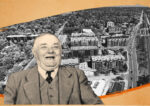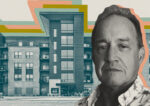The LoA pair of Mount Prospect-based developers have transformed the village’s downtown core with the addition of almost 600 rental units across six developments.
Over the last five years, the Papanicholas and Lowe families have completed half a dozen high-end apartment buildings, introducing 595 units, Crain’s reported.
The properties have revitalized the area by attracting new residents and boosting local foot traffic. It has also enabled the opening of long-awaited amenities like restaurants, a grocery store and nightlife venues.
One of the standout projects is Wingspan Development Group’s Dawson, a 64-unit building at 235 East Prospect Avenue. The property, which opened in August, marked the third apartment building completed by the Papanicholas family’s firm, bringing their contribution in the northwest Chicago suburb to 330 rental units.
Meanwhile, Tom Lowe’s partnerships — consisting of Jeff Brown’s T2 Capital Management, Norridge-based Harlem Irving Companies and Itasca developer Hamilton Partners — contributed 265 units across three multifamily developments.
The 88-unit HQ Residences, at 122 East Northwest Highway, was the most recent addition. The building opened in June, with rental prices ranging from $2,100 to $3,230.
The influx of housing has energized Mount Prospect’s downtown economy. Six restaurants have opened in the past year, matching the number from the entire previous decade, according to Jason Shallcross, the village’s community and economic development director.
Whiskey Hill Brewery, which opened in November, is one of the standout additions benefiting from the increased foot traffic. Another major milestone was the 2023 opening of Angelo Caputo’s Fresh Markets, an independent grocery store located within the Maple Street Lofts.
Dawn Fletcher Collins of the Nicholas Family of Companies, called it a “big piece” of the transformation, noting that the downtown had been without a grocery store for 40 years.
However, the projects have not been without controversy. Early plans faced resistance from residents concerned about increased traffic, potential school overcrowding and changes to the neighborhood’s character. Shallcross noted that these fears have not materialized, with the luxury buildings primarily attracting empty nesters and young professionals.
— Andrew Terrell
Read more



